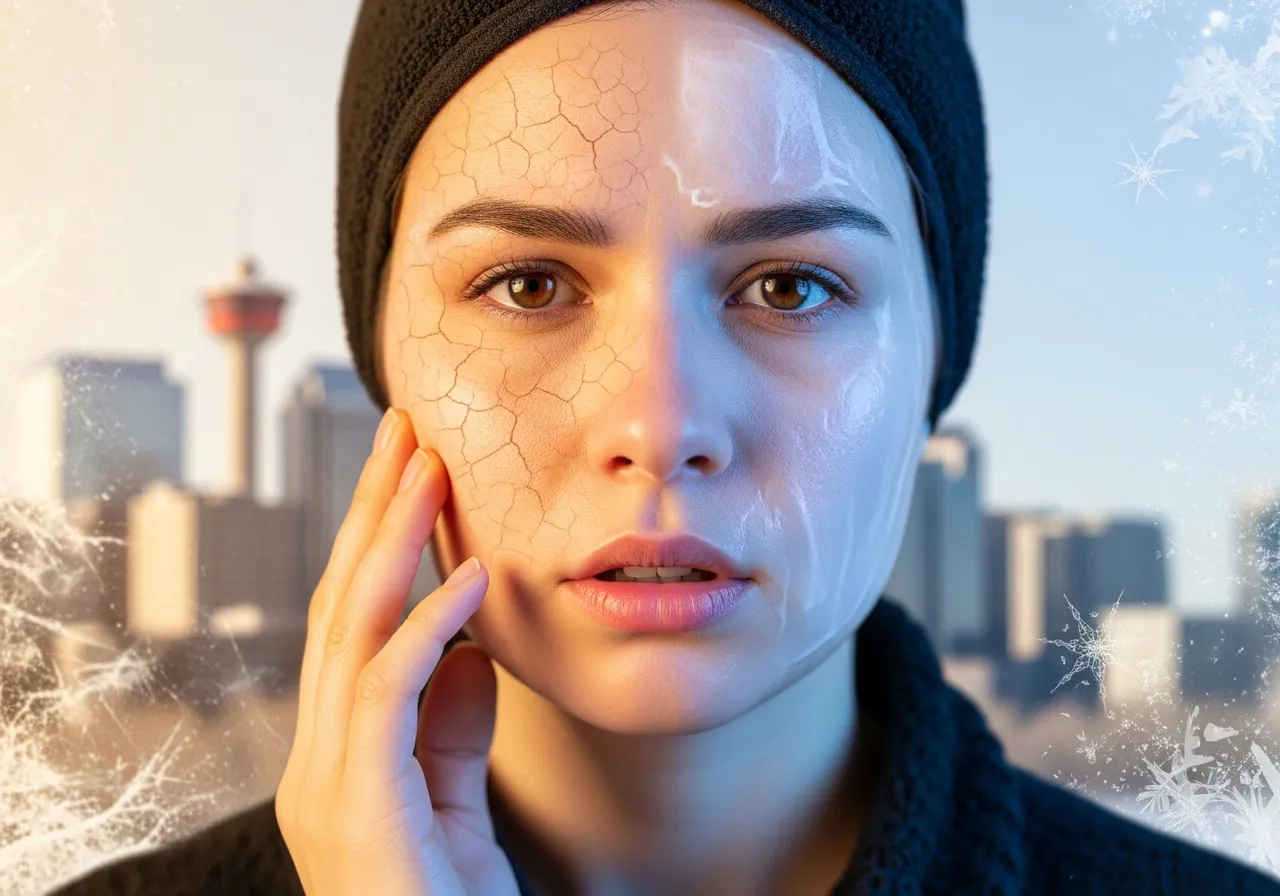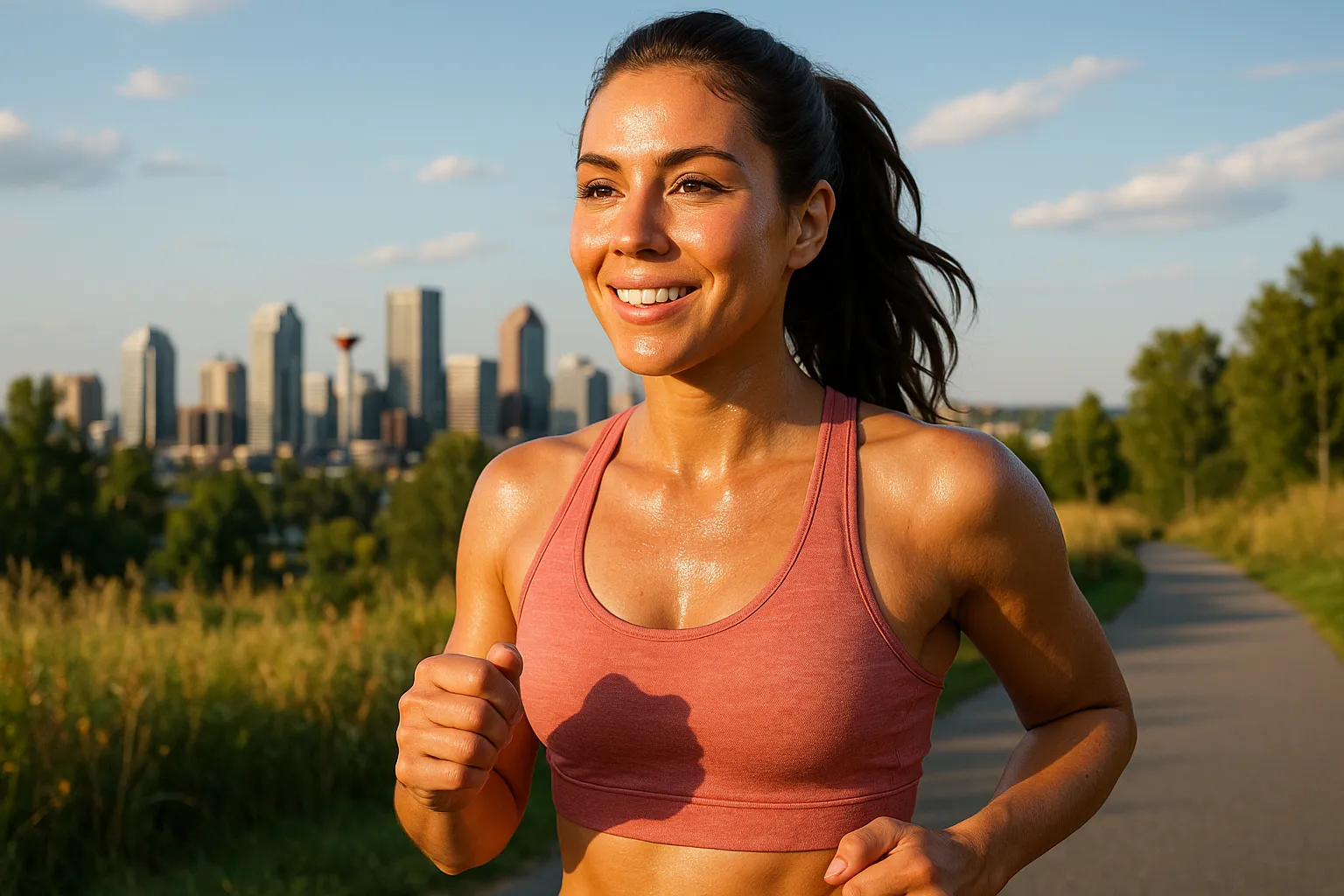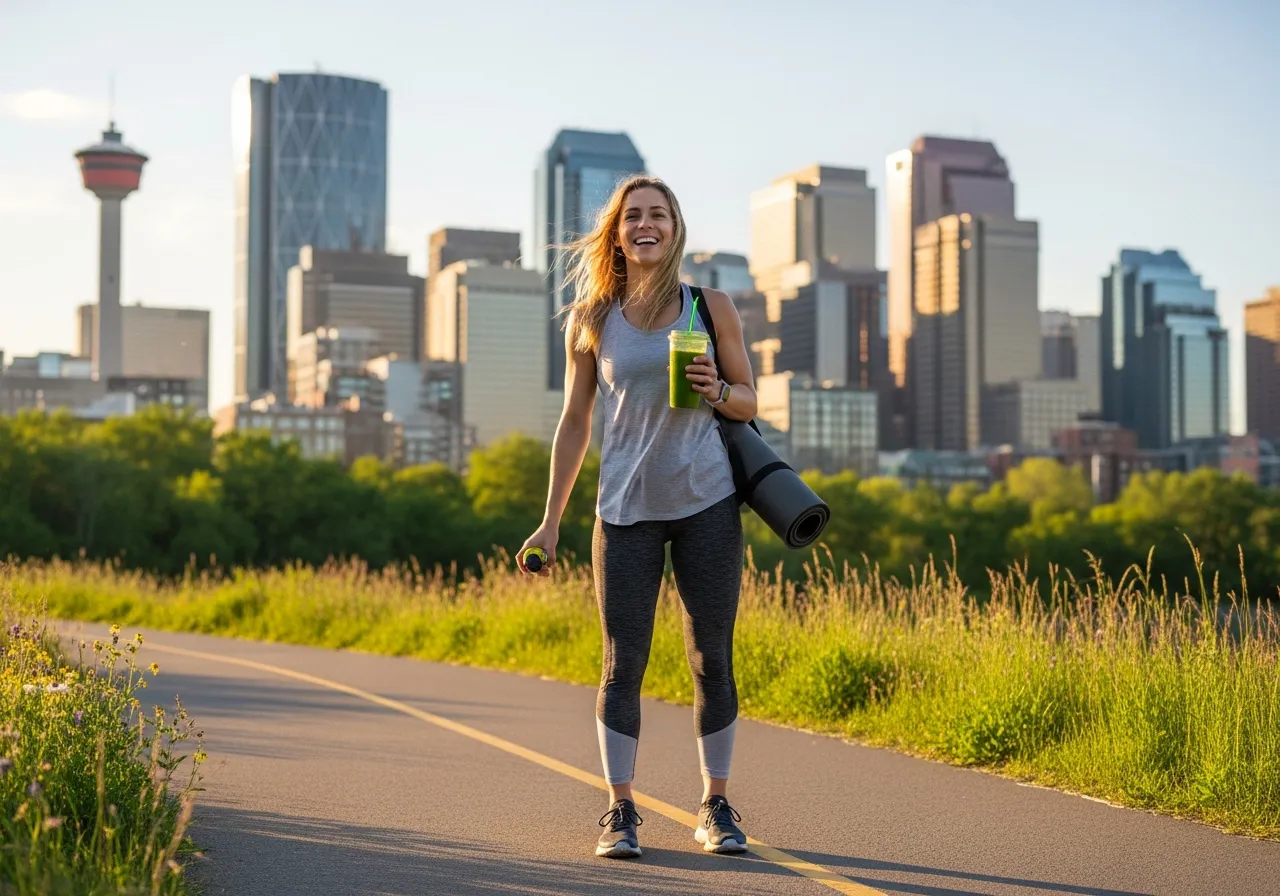Living in Calgary offers incredible advantages—endless blue skies, crisp mountain air, and proximity to world-class outdoor recreation. However, our unique prairie environment creates specific challenges for skin health that many residents don't fully understand until damage becomes visible.
At 1,045 meters above sea level with humidity levels averaging just 30-40% year-round, Calgary's climate consistently works against your skin's natural protective barriers. Add our intense UV exposure, temperature extremes ranging from -30°C to +30°C, and those famous chinook winds, and you have a perfect storm for accelerated aging, chronic dehydration, and persistent skin sensitivity.
Our city experiences over 330 days of sunshine annually—more than Miami. Combined with high altitude and reflective snow cover for 4-5 months, Calgarians face year-round UV exposure that exceeds many tropical locations. Yet most residents still think of sun protection as a "summer only" concern.Understanding Calgary's Unique Environmental Impact on Skin
The Altitude Factor: Why Elevation Matters
Calgary's elevation isn't just a geographical statistic—it directly impacts your skin health in ways that become more pronounced over time. Every 300 meters of elevation increases UV exposure by 4%, meaning at our altitude, you're receiving 10-15% more UV radiation than at sea level. This thinner atmosphere provides less protection, allowing more direct solar radiation to reach your skin while simultaneously accelerating transepidermal water loss through lower air pressure.
The enhanced free radical damage from this increased UV exposure creates more oxidative stress than your skin would experience in lower-elevation cities, accelerating cellular aging processes that become visible over years of exposure. During our 4-5 month winter season, fresh snow reflects up to 80% of UV rays back toward your face—essentially doubling your UV exposure. This phenomenon explains why many Calgarians develop unexpected sun damage and pigmentation during winter months, especially around the eyes and cheekbones where the reflected light concentrates.
Humidity Crisis: The Invisible Skin Thief
Calgary's consistently low humidity is perhaps the most underestimated factor in skin aging for local residents. While optimal skin health requires humidity levels between 50-60%, Calgary's average hovers at just 30-40% year-round, dropping to a desert-like 15-20% during winter heating season. This chronic low humidity environment causes visible dryness to appear within just 2-3 days of exposure, but the long-term effects are far more concerning.
Chronic dehydration from low humidity doesn't just cause surface dryness—it fundamentally compromises your skin's barrier function, leading to premature fine lines, increased sensitivity to products and environmental stressors, and significantly slower skin repair processes. Your skin's natural ability to retain moisture becomes impaired, creating a cycle where even well-moisturized skin feels tight and uncomfortable.
Temperature Extremes and Skin Stress
Calgary's dramatic temperature swings present challenges that most skincare advice doesn't address. Our city can experience summer heat waves followed by arctic chills within the same week, forcing your skin into constant adaptation mode. This repeated expansion and contraction of blood vessels leads to broken capillaries and persistent redness that many Calgarians mistake for natural coloring.
The constant temperature stress weakens your skin's protective barrier while making it more reactive to products and treatments that worked fine in stable climates. Most concerning is how these extreme weather conditions interfere with your skin's cellular repair processes, slowing the natural healing and regeneration that keeps skin looking youthful and healthy.
Most Common Calgary Skin Concerns
Chronic Dehydration and Barrier Damage
The most prevalent skin concern among Calgary residents is chronic dehydration that goes far beyond surface-level dryness. You'll notice this as skin that feels tight and uncomfortable even after moisturizing, fine lines that appear more pronounced in the morning, and makeup that doesn't sit well or looks patchy by midday. This occurs because our dry air constantly pulls moisture from your skin faster than it can be naturally replenished, while indoor heating during our long winter season compounds the problem by creating desert-like conditions.
This chronic moisture loss doesn't just affect appearance—it fundamentally compromises your skin's barrier function, making it more susceptible to irritants, environmental damage, and premature aging. The barrier disruption creates a cycle where even expensive moisturizers fail to provide lasting relief because the underlying structure that holds moisture has been compromised.
Premature Photoaging
Calgary residents frequently develop signs of sun damage that typically appear 5-10 years earlier than those living at lower elevations. You'll first notice fine lines appearing around the eyes and mouth, followed by brown spots and uneven pigmentation across the face, particularly on the forehead, cheeks, and nose where UV exposure is most concentrated. The loss of skin elasticity and firmness happens gradually but consistently due to year-round high UV exposure that breaks down collagen and elastin faster than in lower-elevation cities.
What makes Calgary's photoaging particularly challenging is that much of it occurs during activities residents don't associate with sun exposure—winter skiing, spring hiking, or even just walking downtown on a bright day. The combination of direct UV rays and ground reflection creates a continuous assault on skin structures that support youthful appearance.
Persistent Redness and Sensitivity
Many Calgary residents develop what appears to be a permanent flush to their cheeks, which actually represents chronic inflammation from constant temperature fluctuations and wind exposure. This presents as cheeks that stay red even indoors, skin that suddenly reacts to products that used to be perfectly fine, and stinging or burning sensations when moving between temperature extremes—like stepping outside on a winter day or entering air conditioning during summer.
This sensitivity develops as the skin struggles to maintain barrier function under constant environmental stress. The repeated inflammation weakens the skin's natural defenses, creating a hypersensitive state where normal environmental changes become uncomfortable and even minor irritants can trigger significant reactions.
Uneven Texture and Dullness
Calgary's environmental stressors create a distinctive skin texture that many residents accept as normal aging, but is actually environmental damage that can be addressed. You'll notice rough, bumpy texture particularly on the cheeks and forehead, skin that looks consistently tired despite adequate sleep, and enlarged pores that seem to get worse over time, especially around the nose and cheek area.
This texture change occurs because our dry air slows the natural cellular turnover process, allowing dead skin cells to accumulate rather than shedding efficiently. Combined with UV damage that creates uneven surface changes and chronic dehydration that makes pores appear larger and more prominent, the overall effect is skin that looks older and more weathered than it should for your age.
Most Effective Medical Aesthetic Treatments for Calgary Skin
Injectable Skin Boosters: The Hydration Game-Changer
For Calgary's chronic dehydration issues, injectable skin boosters represent one of the most transformative solutions available to local residents. These treatments work by injecting hyaluronic acid directly into the dermis, where it can attract and hold up to 1,000 times its weight in water. Unlike topical moisturizers that sit on the surface, skin boosters provide deep hydration that lasts 6-9 months, giving your skin consistent moisture through our dramatic seasonal changes.
What makes skin boosters particularly effective in Calgary's climate is their ability to stimulate natural collagen production while improving overall skin thickness and resilience. This dual action helps skin better handle our humidity fluctuations and temperature extremes. Many Calgary clients report experiencing their first comfortable, pain-free winter after treatment, as the deep hydration prevents the tight, cracked feeling that typically accompanies our heating season.
The treatment is particularly beneficial for anyone experiencing chronic dryness that doesn't respond to even the most intensive skincare routines. It's ideal for busy professionals who spend time in climate-controlled offices, outdoor enthusiasts who face constant environmental exposure, and anyone who has noticed their skin never feels truly moisturized despite consistent product use.
IPL Photofacial: Reversing Sun Damage
Calgary's intense year-round UV exposure makes IPL (Intense Pulsed Light) one of the most valuable treatments for local residents dealing with accumulated sun damage. The treatment uses broad-spectrum light to target melanin deposits from UV damage, effectively fading sun spots and age spots while simultaneously addressing the persistent redness and broken capillaries that result from our temperature extremes.
What sets IPL apart for Calgary residents is its versatility in addressing multiple concerns simultaneously. The same treatment that fades brown spots from summer hiking also reduces the facial flushing that develops from constantly moving between heated indoor spaces and cold outdoor air. The treatment works progressively, typically requiring 3-5 sessions spaced four weeks apart, with optimal results appearing when performed during our lower-UV months from September through March.
Clinical data shows that over 90% of Calgary IPL clients see significant improvement in both sun damage and redness, with many reporting they look 5-10 years younger after completing a full treatment series. The key is finding a provider who understands how to adjust treatment parameters for Calgary's specific climate-induced damage patterns.
Microneedling with PRP: Climate Damage Repair
This combination treatment addresses the multiple environmental stressors that Calgary residents face by stimulating your skin's natural repair mechanisms while providing concentrated growth factors through platelet-rich plasma (PRP). The microneedling process creates controlled micro-injuries that trigger collagen production, helping repair UV damage and improve skin texture, while the PRP component accelerates healing and provides additional regenerative benefits.
For Calgary skin, this treatment excels at improving the rough, uneven texture that develops from years of environmental exposure while simultaneously boosting the skin's ability to retain moisture. The process also enhances the penetration of topical treatments, making your existing skincare routine more effective in our challenging climate.
Timing is crucial for optimal results in Calgary. Fall and winter treatments allow for proper healing without UV interference, while spring treatments prepare your skin to better handle the upcoming season of intense outdoor activities. Many clients notice improved skin resilience after just one treatment, with full results developing over the following months as new collagen forms.
Customized Chemical Peels: Renewal for Prairie Skin
Chemical peels for Calgary residents require careful customization to account for our climate's impact on skin barrier function. Standard peel protocols often prove too aggressive for skin that's already compromised by chronic dehydration and environmental stress. Calgary-adapted peels use gentler acid concentrations while incorporating moisture-binding ingredients to prevent over-drying in our low-humidity environment.
The most effective approach for Calgary residents typically involves a series of lighter peels rather than single deep treatments. This allows your skin to adapt gradually while maintaining barrier function throughout the treatment process. The peels are timed strategically during low-UV months, with extended healing protocols that account for our dry air conditions.
These customized treatments excel at addressing the cellular buildup that occurs when our dry air slows natural exfoliation processes. By accelerating cell turnover in a controlled manner, peels restore the natural glow that gets dulled by environmental stressors while preparing skin to better handle Calgary's challenging climate conditions.
Advanced Laser Treatments: Precision Repair
Fractional laser treatments offer targeted solutions for the specific damage patterns that develop in Calgary's environment. These treatments work by creating controlled micro-zones of thermal injury that stimulate healing and collagen remodeling, effectively addressing texture issues, pigmentation, and fine lines that result from chronic UV and environmental exposure.
Different laser technologies serve different purposes for Calgary residents. Fraxel excels at improving overall texture and addressing widespread sun damage, while CO2 fractional lasers provide deeper resurfacing for more significant damage. Erbium lasers offer a gentler option for sensitive skin that's been compromised by climate stress, and Q-Switch lasers provide targeted removal of stubborn pigmentation.
Calgary considerations for laser treatments include extended healing times due to our dry air and the critical importance of year-round sun protection protocols. However, when properly planned and executed, laser treatments can dramatically improve skin that's been compromised by years of environmental exposure, often providing results that skincare alone cannot achieve.
Seasonal Treatment Planning for Calgary
🍂 Fall (September-November): Prime Treatment Season
- Ideal For: IPL, chemical peels, laser treatments, deep microneedling
- Why: Reduced UV exposure allows for aggressive treatments
- Focus: Address summer sun damage before winter dryness sets in
- Preparation: Build up skin barrier strength before heating season
❄️ Winter (December-February): Maintenance and Hydration
- Ideal For: Skin boosters, gentle peels, hydrating facials
- Why: Combat extreme dryness from heating and low humidity
- Focus: Intensive hydration and barrier repair
- Caution: Avoid aggressive treatments during chinook season
🌸 Spring (March-May): Renewal and Preparation
- Ideal For: Microneedling, light peels, laser maintenance
- Why: Prepare skin for increased UV exposure
- Focus: Strengthen skin before summer outdoor activities
- Timing: Complete treatments by May to avoid peak sun
☀️ Summer (June-August): Protection and Gentle Care
- Ideal For: Maintenance treatments, gentle facials, touch-up injections
- Why: Minimize aggressive treatments during peak UV
- Focus: Maintain results while protecting from sun damage
- Essential: Strict sun protection protocols for all treatments
Essential Calgary Skincare Protocol
Daily Defense Strategy
- Gentle Cleanser: Cream or oil-based, never foaming in dry months
- Antioxidant Serum: Vitamin C to combat free radical damage
- Hyaluronic Acid: Apply to damp skin, seal with moisturizer
- Rich Moisturizer: Look for ceramides and fatty acids
- SPF 30+ Daily: Mineral formulas work best in our climate
- Double Cleanse: Remove sunscreen and environmental pollutants
- Treatment Products: Retinoids (start slow), peptides, or niacinamide
- Hydrating Layers: Hyaluronic acid, then face oil if needed
- Night Moisturizer: Heavier than morning formula
- Humidifier: Run nightly to combat indoor dryness
Calgary-Specific Product Recommendations
- Hyaluronic Acid: Multiple molecular weights for deep and surface hydration
- Ceramides: Repair and strengthen compromised barriers
- Niacinamide: Reduces redness and regulates oil production
- Squalane: Lightweight oil that mimics skin's natural sebum
- Zinc Oxide: Physical sunscreen that won't irritate sensitive skin
Environmental Modifications
- Home Humidity: Maintain 40-50% with humidifiers during heating season
- Water Temperature: Use lukewarm water only—hot water strips natural oils
- Indoor Air: Consider air purifiers to reduce environmental stressors
- Hydration: Increase water intake at altitude—aim for 2.5-3 liters daily
Seasonal Treatment Planning for Calgary
Understanding when to schedule treatments in Calgary's climate can dramatically impact your results and recovery experience. Our city's extreme seasonal variations create distinct windows of opportunity for different types of interventions, with timing considerations that don't apply in more temperate climates.
Fall: Prime Treatment Season
September through November represents the ideal window for intensive treatments in Calgary. UV exposure begins declining significantly after Labour Day, while temperatures remain mild enough for comfortable healing. This is when you should schedule IPL treatments, deeper chemical peels, laser resurfacing, and any procedure that requires extended sun avoidance. The goal during fall is to address accumulated summer damage before winter's harsh conditions set in, while also building up your skin's barrier strength to handle the upcoming heating season.
Winter: Maintenance and Deep Hydration
December through February calls for a maintenance approach focused on combating the extreme dryness from indoor heating and low humidity. This season is ideal for skin boosters, gentle hydrating facials, and light peels that won't compromise your already-stressed barrier function. However, avoid aggressive treatments during chinook periods when rapid temperature and humidity changes can interfere with healing. The focus should be intensive hydration and barrier repair to prevent the cumulative damage that winter conditions can cause.
Spring: Renewal and Preparation
March through May offers another excellent treatment window, particularly for microneedling, moderate peels, and laser maintenance sessions. The key is completing any significant treatments by early May, before Calgary's intense summer UV exposure begins. Spring treatments should focus on strengthening and preparing your skin for the upcoming months of outdoor activities, hiking, and festival season. This is also an excellent time for skin boosters that will provide hydration support through the drying effects of summer sun and wind.
Summer: Protection and Gentle Care
June through August requires the most conservative approach to treatments. Focus on maintenance procedures, gentle facials, and touch-up injections for those who need them. Any treatment performed during this period requires strict sun protection protocols, which can be challenging given Calgary's outdoor lifestyle. The priority shifts from treatment to protection, ensuring that previous investments in your skin aren't compromised by UV damage.
Essential Calgary Skincare Protocol
Building an effective skincare routine for Calgary's climate requires understanding that standard advice doesn't account for our unique environmental stressors. Your routine needs to be robust enough to handle extreme conditions while gentle enough not to further compromise barrier function.
Morning Defense Strategy
Your morning routine serves as daily armor against Calgary's environmental challenges. Start with a gentle, cream-based cleanser that won't strip natural oils—avoid foaming cleansers entirely during dry months as they can worsen barrier compromise. Follow with a potent antioxidant serum containing vitamin C to combat the enhanced free radical damage from high-altitude UV exposure.
Hyaluronic acid should be applied to slightly damp skin and immediately sealed with a rich moisturizer containing ceramides and fatty acids. This layering technique maximizes moisture retention in our low-humidity environment. Finish with broad-spectrum SPF 30 minimum, though SPF 50+ is recommended for extended outdoor exposure. Mineral formulas with zinc oxide tend to work best in Calgary's climate as they provide immediate protection without irritating wind-damaged skin.
Evening Repair Protocol
Your evening routine focuses on repairing daily environmental damage while preparing skin to handle another day of climate stress. Double cleansing becomes essential to remove the combination of sunscreen, environmental pollutants, and the natural buildup that occurs in dry climates. Start with an oil-based cleanser followed by a gentle cream cleanser.
Treatment products like retinoids should be introduced slowly and carefully—Calgary's compromised skin barriers make everyone more sensitive to active ingredients. Begin with the lowest concentration twice weekly, building tolerance gradually. Layer hydrating ingredients like hyaluronic acid under a heavier night moisturizer, and consider adding a face oil if your skin remains tight despite moisturizing.
Running a humidifier nightly becomes crucial during heating season, as it can dramatically improve how your skin looks and feels in the morning. This simple environmental modification often provides more benefit than expensive serums in our dry climate.
Environmental Modifications
Beyond products, environmental modifications can significantly impact your skin's health in Calgary. Maintain home humidity levels between 40-50% using humidifiers during the heating season—this single change can prevent much of the barrier damage that occurs during our long winters.
Water temperature matters more in our climate than in humid environments. Use only lukewarm water for cleansing, as hot water will strip the natural oils your skin desperately needs to maintain in our dry conditions. Consider installing a shower filter if you have particularly hard water, as mineral deposits can further irritate compromised skin barriers.
Increase your water intake to account for altitude and dry air—aim for 2.5-3 liters daily, more during outdoor activities. The enhanced metabolism and breathing rate at altitude, combined with low humidity, increases fluid loss beyond what most hydration recommendations account for.
Choosing the Right Calgary Provider
Finding a qualified aesthetic provider who understands Calgary's specific climate challenges is crucial for achieving optimal results. Many providers use standard protocols that don't account for the unique skin conditions created by our prairie environment, leading to suboptimal outcomes or unnecessary complications.
Look for providers who demonstrate genuine understanding of how Calgary's climate affects treatment outcomes and healing processes. They should modify standard treatment protocols for our dry environment, understand the importance of seasonal timing, and have experience managing the sensitive, barrier-compromised skin that many Calgary residents develop.
Ask potential providers specific questions about their experience with Calgary's climate effects on skin. How do they modify chemical peel protocols for low humidity? What post-treatment care do they recommend for our dry conditions? Do they adjust laser parameters for altitude effects on healing? Providers familiar with our environment will have detailed, specific answers.
Verify that they use only Health Canada-approved products and maintain proper storage conditions—this is particularly important for injectables like hyaluronic acid that can be damaged by temperature fluctuations. The clinic should feel medical-grade rather than spa-like, with proper emergency protocols and equipment visible.
Most importantly, they should prioritize education and realistic expectations over sales pressure. Calgary's climate creates unique challenges that may require modified treatment approaches or extended timelines, and qualified providers will explain these factors rather than offering unrealistic promises.
Frequently Asked Questions
Protecting Your Skin in Calgary's Unique Environment
Calgary's climate presents challenges that generic skincare advice simply doesn't address. Our combination of high altitude, intense UV exposure, low humidity, and extreme temperature fluctuations creates a perfect storm for accelerated skin aging and chronic sensitivity.
However, understanding these challenges is the first step toward overcoming them. With the right combination of climate-adapted skincare, strategically timed treatments, and environmental modifications, you can maintain healthy, resilient skin despite our demanding prairie conditions.
Your skin deserves protection that matches the intensity of Calgary's environment—invest in solutions designed for our unique climate challenges.



